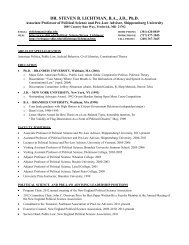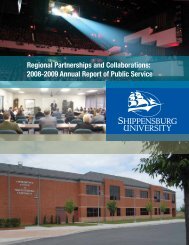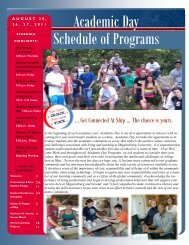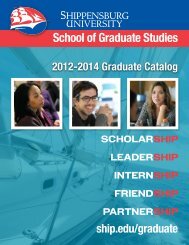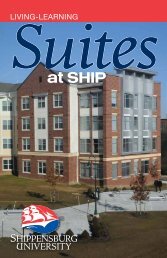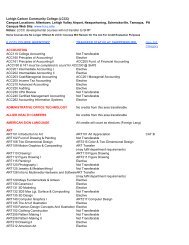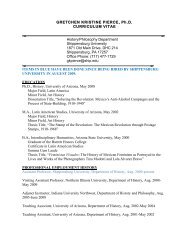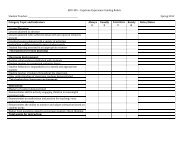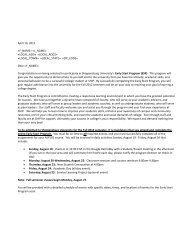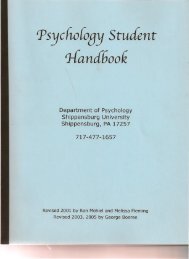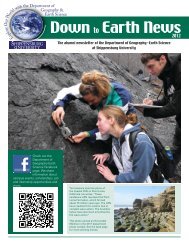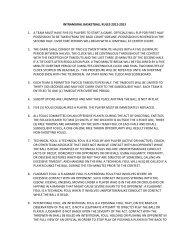Gail Cowie, Leigh Askew and Courtney Tobin: Georgia’s Water Future 21Figure 1. Basin Advisory Committees used indevelopment of Georgia’s 2008 State Water Planprovide structured statewide perspectives on watermanagement policy tools and/or options. SACparticipants were asked to speak for their entireorganization, members of which occasionally haddifferent and/or competing interests in various partsof the state. Membership on the SAC replicatedthe diversity seen in the BAC membership, withleaders from the environmental, business, industry,recreation, and agricultural sectors, and city and countygovernment associations. Again, the intention of theSAC was not to build consensus, but to gather inputfrom a broad range of perspectives to determine thecorrect course for water management in the state.In order to gain as much input as possible in thetime available, advisory committee meetings were led byprofessional, neutral facilitators. Each meeting focusedon specific water management objectives or practices(e.g., meeting instream and offstream needs for water,maintaining water quality). BAC meetings on each setof topics preceded the SAC meetings on those topics.Prior to each meeting, committee members receiveda discussion paper prepared by agency staff. 10 BACmeetings were structured to provide basic informationon the topic and then garner opinions and commentson proposed policy options. Facilitators providedreports summarizing the discussion that occurred at theBAC meetings, which were, in turn, used to revise theproposed policy options for the SAC’s consideration.Input from the BAC often highlighted the topics orpolicy options that were particularly controversial. Thisinput helped shape the agendas for the SAC meetings.In addition, because SAC members were primarilyprofessional staff from statewide organizations, thecommittee could delve into specific proposals in greaterdetail. For example, due to the extensive amount ofcomment and concern over interbasin transfers andsurface storage in the BAC meetings, those topicswere given additional time and addressed at a separateSAC meeting. Similarly, a computer model designed toestimate the amount of water available for use withoutadversely affecting downstream interests, a criticalelement of water planning, received detailed attentionin SAC meetings.Advisory committee outcomesOne of the challenges that faced the advisorycommittees was meetings were not designed to buildconsensus on a given topic. Instead, facilitators soliciteda variety of opinions on each management objective tohelp shape an acceptable management plan. Creationof the management plan reflected Georgia’s need tochange its framework for water management, turningfrom managing under conditions of plenty to managingfinite capacities of water resources. With such broadrepresentation on each committee, a goal of gatheringinformation from divergent perspectives, and givencompeting interests for water resources, the possibilityof reaching consensus on all objectives was low.Despite this challenge, a mail survey sent to basinadvisory committee members indicated a high levelof satisfaction among participants. The survey wasdistributed to all basin advisory committee membersapproximately eight months after the process wascompleted and 35 percent of participants responded. 11Respondents indicated overwhelming satisfactionwith the process itself. Of the survey respondents, 66percent were mostly or very satisfied with the overallprocess. This result indicates BAC members werecomfortable not seeking consensus. Simply havingthe opportunity to express their opinions about themanagement objectives, and exchange views withmembers from other sectors, was satisfactory for themajority of respondents.Respondents overwhelmingly agreed the compositionof their BAC was reflective of their region. Morethan 92 percent reported the membership balance ontheir specific BAC brought together the diverse interestsin their watershed. However, there was frustrationexpressed in the lack of attendance on occasion and thetendency of some members to bring extreme views tothe table.Survey respondents reported the facilitated meetingswere conducive to open and honest communicationswith 88 percent either agreeing or mostly agreeing withthis statement. This statistic reflects an appreciation forthe structure of the meetings and participants’ abilityto express their opinions and to hear those of others.
22 PROTEUS: A Journal of IdeasMembers were allowed and expected to disagree, butthat generally did not derail the discussions or impactrespondents’ ability to freely express their opinions.The policy options proposed by agency staff wererevised in response to multiple rounds of input from theadvisory committees, and the working documentschanged considerably over the 18-month course ofadvisory committee meetings. Among other specifics,discussion at advisory committee meetings emphasizedthe need for flexibility to adapt to differing circumstancesin different regions of the state. Many also feltit was critical to maintain a full range of managementpractices as future options. At the same time, advisorycommittee members stressed the need for actions toensure equity among different users, across differentregions and river basins, and between upstream anddownstream interests. Finally, advisory committeemembers strongly urged action be taken to fillinformation and data gaps before significant policycommitments are made. Revisions of staff proposalsincluded provisions intended to address these majorconcerns as well as a number of specific issues.This evolution in the content of the plan isreflected in responses to a final survey question aboutimpact. BAC members who responded to the surveygenerally felt their input, meaning their comments anddiscussions about the water management objectives,was reflected in the final state water management plan.Sixty percent of respondents reported the BAC processhad some or considerable impact on the final plan.Respondents generally felt the final management planwas responsive to the comments received and theircomments and opinions were integrated into the finalplan.Results: Georgia’s 2008 statewide water planIn January 2008, a final Comprehensive StatewideWater Management Plan was submitted to the GeorgiaGeneral Assembly. It was adopted by over 75 percentof the vote in both houses of the legislature and signedinto law by the governor in February 2008. The highlevel of support among elected officials was due, inpart, to the breadth of engagement and support builtthrough the broad-based technical and public inputprocess.The final plan has three major elements thatbuild toward more sustainable management of thestate’s water resources. The first is a series of resourceassessments focused on water quantity and waterquality. Assessments will be conducted following majorhydrologic boundaries to evaluate, in a consistentmanner statewide, the water available for use and thecapacity to assimilate wastewater.Water quantity assessments will estimate thecapacity of individual water sources to provide waterfor use in a certain area while supporting other usesdownstream or from that same aquifer. For surfacewater sources, the emphasis is on avoiding significantdeviations from historic flow patterns and so, protectingdownstream users. Water quality assessments will lookfrom a watershed perspective at wastewater treatmentlevels that are required to protect water quality. Theseassessments are the first step in moving away fromthe first-come, first-serve system for permitting waterwithdrawals and wastewater discharges that hasdeveloped over the past few decades.Resource assessments, in turn, provide the startingpoint for regional water planning, the second criticalstep in the evolution of Georgia’s water managementinstitutions. In a guiding policy statement, the StateWater Plan recognizes the following: “The characteristicsof water resources and water users vary significantly indiffering regions across Georgia. Protecting the ability ofthe state’s water resources to meet needs for water supplyand assimilation of wastewater will require regional,resource-based plans that identify the management practicesappropriate to the resources and users in each region.”The State Plan then lays out a framework fordevelopment of regional plans that will span theentire state (Figure 2). As noted above, one regionalwater planning district was created in 2001, out ofconcern for growing demand and increasing stresseson water resources in the Atlanta metro area. TheState Water Plan extends regional planning to allareas of the state, including those that do not yet haveevidence of resource stress. It establishes ten WaterPlanning Councils to guide development of regionalplans. Members are to be appointed by the governor,lieutenant governor, and speaker of the house and,collectively, councils are to be broadly representative ofthe water-related interests in the region.Through regional planning, water managementpractices will be selected, specified, and laid out forimplementation. The State Water Plan providesguidance on use of practices to manage water qualityas well as water supply, including water conservation,surface water storage, interbasin transfers, andmanagement of nonpoint source pollution, amongothers. Implementation of regional plans will primarilyoccur through actions at the local level and, onceregional plans are adopted, state law requires waterwithdrawal permits and state grants and loans beconsistent with their provisions.Finally, state law and the State Water Plan requireperiodic review and revision of plans on a three to fiveyear cycle. Regional plans are to include benchmarksfor assessment of plan effectiveness and identificationof necessary revisions. Periodic review and revision ofthe state plan and the regional plans enables adaptiveresponses to changes in water use, forecasted demands,and resource conditions.Resource assessments are currently underway.Preparation of regional plans is expected to begin inearnest in spring 2009, following appointment of the



